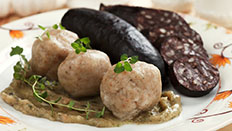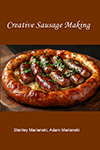Meats and Sausages
Morcela de Assar de Portalegre
Morcela de Assar de Portalegre is a Portuguese smoked blood sausage from the district of Portalegre. As early as 1750 reference was made to these products, attesting to the reputation enjoyed by the pork products produced in the Portalegre area. The raw material is derived from pigs of the Alentejo breed, raised in the open air, under extensive or semi-extensive conditions, in an agroforestry system (basic feed being grass and acorns) in the oak forests of the Alentejo region.
It is made from fat (neck, belly, back fat) and blood from pigs of the Alentejo breed with addition of salt, ground dried ungerminated garlic, cumin, sweet pepper and, occasionally, wine from the Portalegre region.
Morcela de Assar de Portalegre carries PGI, 1997 classification.
| Meats | Metric | US |
|---|---|---|
| Pork fat trimmings (belly, neck or back fat) | 600 g | 1.32 lb |
| Pork blood | 400 ml | 0.88 lb |
Ingredients per 1000g (1 kg) of meat
| Salt | 28 g | 5 tsp |
| Pepper | 2.0 g | 1 tsp |
| Paprika, sweet | 2.0 g | 1 tsp |
| Cumin | 2.0 g | 1 tsp |
| Garlic, powder | 5.0 g | 1 tsp |
Instructions
- Cut fat into 5/8” (10 mm) pieces.
- Mix fat, blood and spices.
- Stuff into 20-40 mm hog casings making 40 cm long horseshoe-shaped rings, with a cotton string tied or twisted around the ends.
- Smoke for 10 days with oak wood at 18° C (64° F).
- Store at a temperature of between 5° C and 15° C. It can be eaten as it is, roasted, fried or boiled. It is used as an ingredient in many of the traditional local dishes, the most famous of which is cozido à portuguesa. It is also often eaten as a starter or as an aperitif.


















